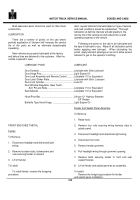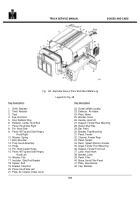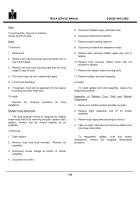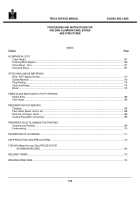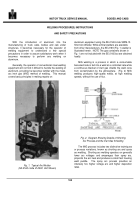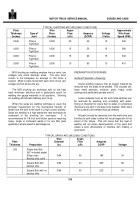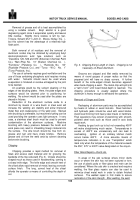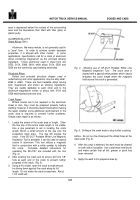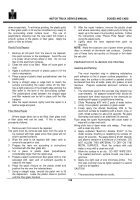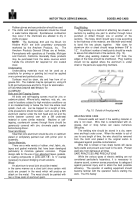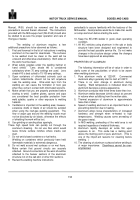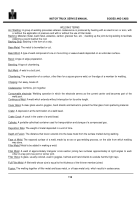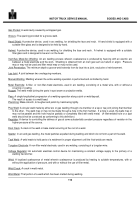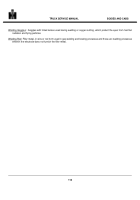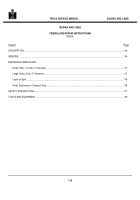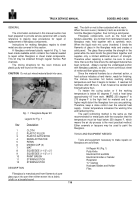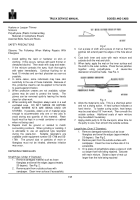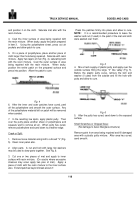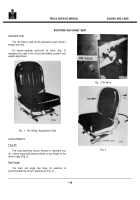TM-5-3805-254-14-P-2 - Page 112 of 894
MOTOR TRUCK SERVICE MANUAL
BODIES AND CABS
Rubber gloves and eye protection should be used.
2.
The cloths and masking materials should be rinsed
in water before disposal.
Spontaneous combustion
may occur if the chemicals are allowed to dry in
cloths or paper.
NOTE
:
The Alumiprep #33 and the Brush On
Alodine #1201 are both proprietary compounds
marketed by the Amchem Products, Inc.
The
Amchem Products General Offices are at Ambler,
Pennsylvania with operations at Ferndale, Michigan
and Fremont, California. Generally these products
may be purchased from the same sources which
handle the Lithoform #2 required for zinc coated
steel.
Undercoating
Undercoating materials must not be used as a
substitute for priming or painting but must be applied
over a primed and painted surface.
Surfaces must be clean, dry and free from oil or
grease film.
The material may be sprayed on, using 20
to 50 psi fluid pressure and 50 to 70 psi for atomization.
ATTACHING UNLIKE MATERIALS TO
ALUMINUM
Bolts and Self-Tapping Screws
All bolts and self-tapping screws must be zinc or
cadmium plated.
Where bolts, washers, nuts, etc.
are
used in locations subject to high moisture conditions--as
in an insulated body or below the floor line where road
splash, mud, etc.
can be trapped for a length of time,
extra precautions should be taken, such as using a 52S
aluminum washer under the bolt head and nut and the
entire fastener covered over with a 3M underseal
material or some similar material.
Machine or self-
tapping, countersunk screws through floors should be
generously covered with zinc chromate paste sealer
before being driven.
Steel (and Brass)
Steel that joins aluminum should be zinc or cadmium
plated or completely painted over with primer prior to
assembly.
Gasket Materials.
There are a wide variety of rubber, vinyl, fabric, etc.
tapes and gasket materials that have been developed
particularly to minimize galvanic corrosion.
Proper
design calls for the use of non-absorbent tapes, gaskets,
or sealing compounds in joints with 1/8’,’ to ¼” overlap
necessary to prevent bridging of salt solutions.
Wood
An aluminum to wood joint should be treated
in the same manner as a steel joint since certain mild
acids are present in the wood which will produce an
attack on the metal.
The wood should be painted with
two or three coats of aluminum paint.
Plug Welding
Plug welding is a method of attaching two sheets or
sections by welding one part to another through holes
punched or drilled through one or another of the
sections.
The holes, which should vary in size according
to the thickness of the material, are filled with weld metal
to bond the two pieces together.
Hole sizes for
aluminum skin or sheet should range between 3/8” to
1/Z”.
A sufficient number of weld points should be made
to assure firm attachment of the sections, (Fig. 10).
When plug welding material over 1/8” thick, the
edges of the holes should be chamfered.
Plug’ welding
should not be applied where the aluminum is under
strain or the parts are supporting members.
Fig. 10.
Details of the plug weld.
WELDING WIRE CARE
Unsound welds will result if the welding material or
wire is not clean.
Wire that is contaminated with oil,
grease, dust or shop fumes can cause numerous
difficulties.
The welding wire should be stored in a dry, warm
area and kept under cover.
When the welder is out of
use for any length of time, the wire should be removed
from the torch and placed in the original carton to
safeguard against possible contamination.
Wire that is kinked or has sharp bends will cause
faulty welds and prevent even feed to the work.
Protect
weld wire from damage at all times.
SAFE PRACTICES AND PRECAUTIONS
While the various types of electric welding are not
considered particularly hazardous, it is necessary to
observe sound, common sense procedures to safeguard
against personal injury and to attain the best possible
efficiency.
The operator of welding equipment should
become familiar with the operation before starting the
work.
The IHC Safety
110
Back to Top

